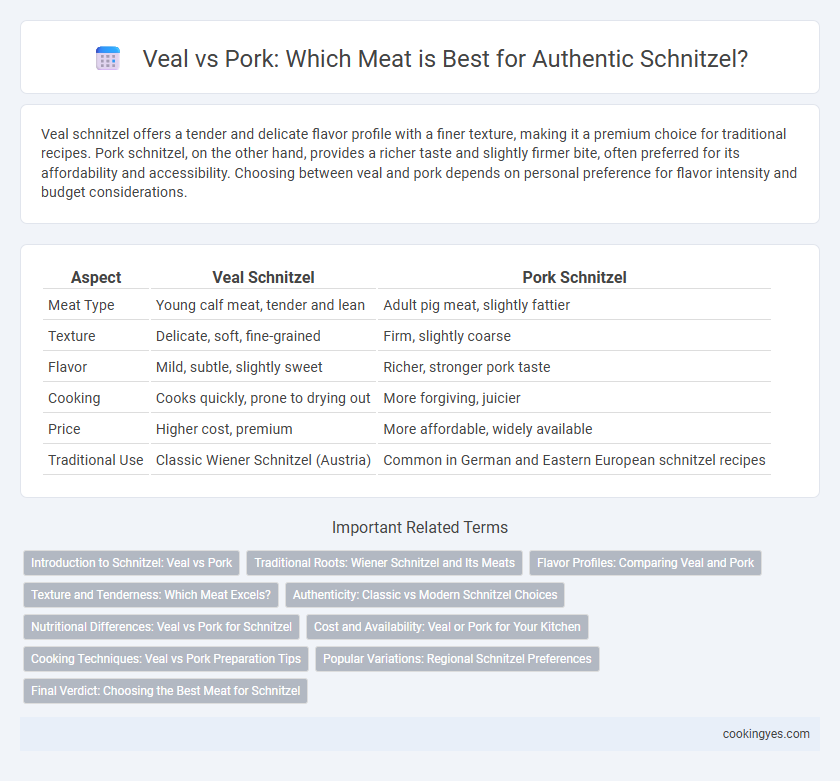Veal schnitzel offers a tender and delicate flavor profile with a finer texture, making it a premium choice for traditional recipes. Pork schnitzel, on the other hand, provides a richer taste and slightly firmer bite, often preferred for its affordability and accessibility. Choosing between veal and pork depends on personal preference for flavor intensity and budget considerations.
Table of Comparison
| Aspect | Veal Schnitzel | Pork Schnitzel |
|---|---|---|
| Meat Type | Young calf meat, tender and lean | Adult pig meat, slightly fattier |
| Texture | Delicate, soft, fine-grained | Firm, slightly coarse |
| Flavor | Mild, subtle, slightly sweet | Richer, stronger pork taste |
| Cooking | Cooks quickly, prone to drying out | More forgiving, juicier |
| Price | Higher cost, premium | More affordable, widely available |
| Traditional Use | Classic Wiener Schnitzel (Austria) | Common in German and Eastern European schnitzel recipes |
Introduction to Schnitzel: Veal vs Pork
Schnitzel, a classic breaded and fried cutlet, is traditionally made with veal or pork, each offering distinct textures and flavors. Veal schnitzel boasts a tender, delicate meat, prized for its subtle taste and fine grain, making it a premium choice in many European cuisines. Pork schnitzel, on the other hand, provides a heartier, richer flavor profile with a slightly firmer texture, often preferred for its affordability and widespread availability.
Traditional Roots: Wiener Schnitzel and Its Meats
Wiener Schnitzel, a traditional Austrian dish, is authentically made from veal, which offers a tender and delicate flavor essential to its classic identity. Pork schnitzel, while more common and economical in many regions, deviates from the original recipe but provides a slightly richer and heartier taste. The choice between veal and pork directly impacts the texture and culinary authenticity, with veal maintaining the traditional roots of Wiener Schnitzel.
Flavor Profiles: Comparing Veal and Pork
Veal schnitzel features a delicate, tender texture with a mild, slightly sweet flavor that highlights the subtle nuances of the meat. Pork schnitzel offers a richer and more robust taste with a firmer texture, providing a heartier eating experience. Flavor profiles differ primarily due to the age and diet of the animals, making veal ideal for lighter, more refined dishes and pork suited for bolder, more savory preparations.
Texture and Tenderness: Which Meat Excels?
Veal schnitzel boasts a delicate texture and superior tenderness due to the younger age and finer muscle fibers of the meat, resulting in a melt-in-the-mouth experience. Pork schnitzel offers a slightly coarser texture with more robust flavor, but can be less tender if not properly pounded or cooked. For those prioritizing softness and a tender bite, veal remains the preferred choice, while pork appeals to those seeking a firmer, heartier schnitzel.
Authenticity: Classic vs Modern Schnitzel Choices
Veal schnitzel is traditionally favored for its tender texture and delicate flavor, embodying the authentic Wiener Schnitzel heritage rooted in Austrian cuisine. Pork schnitzel offers a modern, more affordable alternative with a slightly heartier taste, popular in contemporary variations across Central Europe. The choice between veal and pork meat distinctly defines the classic authenticity versus modern adaptation of schnitzel dishes.
Nutritional Differences: Veal vs Pork for Schnitzel
Veal schnitzel offers a leaner protein option with lower fat content and fewer calories compared to pork schnitzel, making it suitable for calorie-conscious diets. Pork schnitzel typically contains higher levels of saturated fat and cholesterol, impacting heart health differently than veal. Both meats provide essential nutrients like protein and B vitamins, but veal's reduced fat and calorie profile make it a healthier choice for balanced nutrition.
Cost and Availability: Veal or Pork for Your Kitchen
Pork schnitzel is generally more affordable and widely available, making it a cost-effective choice for both home cooks and restaurants. Veal schnitzel offers a tender texture and delicate flavor but is often pricier and less accessible due to limited production and stricter regulations. Choosing pork can reduce expenses and improve supply consistency without sacrificing the traditional schnitzel experience.
Cooking Techniques: Veal vs Pork Preparation Tips
Veal schnitzel requires delicate handling with quick, high-heat pan-frying to preserve its tender texture, while pork schnitzel benefits from a slightly longer cooking time to ensure thorough doneness without drying out. Veal's finer grain means pounding it to an even thinness is essential for uniform cooking, whereas pork, often thicker, may require gentle tenderizing and careful monitoring of internal temperature to reach at least 145degF safely. Both meats demand a light breading of flour, egg wash, and breadcrumbs, but veal's sweetness pairs well with lemon wedges, while pork schnitzel often embraces bolder seasoning flavors like paprika or garlic.
Popular Variations: Regional Schnitzel Preferences
Veal schnitzel, often associated with the classic Wiener Schnitzel from Austria, features tender, lean meat prized for its delicate texture and flavor. Pork schnitzel is more common in Germany and Central Europe, providing a richer taste and slightly firmer bite due to the marbling in pork loin. Regional preferences dictate the choice, with veal preferred in upscale or traditional settings and pork favored for everyday schnitzel dishes.
Final Verdict: Choosing the Best Meat for Schnitzel
Veal schnitzel offers a tender, delicate texture with a subtle flavor, ideal for a classic Wiener Schnitzel, prized in traditional Austrian cuisine. Pork schnitzel provides a slightly richer taste and firmer bite, making it a versatile and budget-friendly option preferred in German and Central European recipes. The best meat for schnitzel ultimately depends on desired tenderness and authenticity, with veal favored for premium dishes and pork for everyday savory enjoyment.
Veal vs pork for schnitzel meat Infographic

 cookingyes.com
cookingyes.com